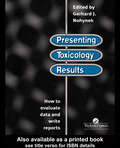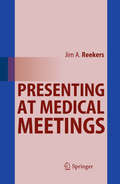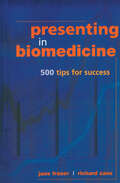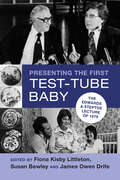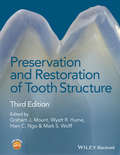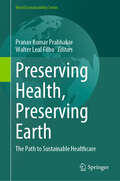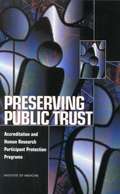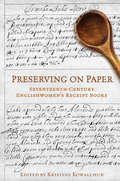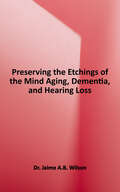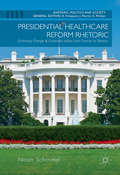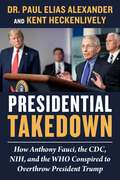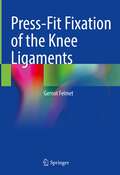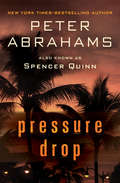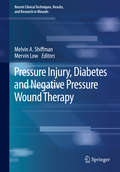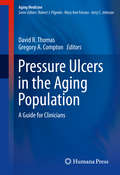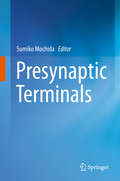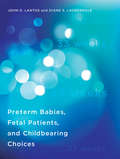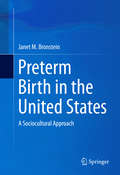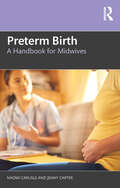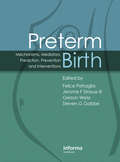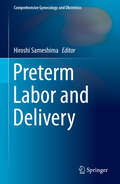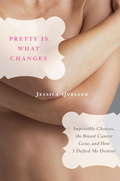- Table View
- List View
Presenting Toxicology Results: How to Evaluate Data and Write Reports
by G. J. NohynekWritten in such a way as to make it accessible to toxicologists who do not have English as a first language, this book focuses on evaluating, interpreting and reporting results of regulatory toxicology studies.
Presenting at Medical Meetings
by Jim A. ReekersLectures on scientific data, educational lectures, and the various other forms of oral presentation are the basis for every medical meeting. Physicians are not professionally trained in giving lectures. This becomes very obvious when one visits a medical meeting. Often the message of the presentation is lost because of poor preparation, slides that fail to communicate effectively, and a generally unconvincing performance by the lecturer. To give a high-quality lecture that will be remembered for its content and form, one first has to learn some basic rules about preparation, PowerPoint slides, and oral communication. This book will enable the reader to overcome all the common presentation mistakes and to start a new career as a professional lecturer and esteemed faculty member.
Presenting in Biomedicine: 500 Tips for Success
by Jane Fraser Richard CaveThe growth in chemotherapy has led to a great need for all those involved to be familiar with safe procedures based on best evidence-based practice. Practical Chemotherapy: a multidisciplinary guide is a comprehensive and straightforward guide describing over 70 widely used chemotherapy regimens helping to make their prescription and administration safer and less problematic. Checklists throughout the book are specifically tailored for the needs of each professional group involved in treatment and are intended to help prevent potentially serious mistakes that can occur. This book is unique in its practical emphasis and will be invaluable for doctors pharmacists and nurses working in oncology and haematology.
Presenting the First Test-Tube Baby: The Edwards and Steptoe Lecture of 1979
by Susan Bewley Fiona Kisby Littleton James Owen DrifeIn January 1979, Robert Edwards and Patrick Steptoe delivered a lecture detailing the ten-year clinical and scientific research programme that led to the birth of Louise Brown, the first baby born utilising IVF. This thoroughly-researched book provides both a full annotated transcript of the lecture as well as recorded reminiscences from those who attended, detailing the contemporary understandings of the event. An essay on the lecture's historical context adds fresh insight into the biographies of Edwards and Steptoe and highlights sources from print and broadcast media that have received scant attention in earlier publications. Current and future implications of the advances in IVF since the first procedure are also explored, examining future medical and scientific possibilities as well as ethical issues that may arise. A foreword by Louise Brown herself places this remarkable leap of science in a personal context, one that so many families have since experienced themselves.
Preservation and Restoration of Tooth Structure
by Wyatt R. Hume Hien C. Ngo Graham J. Mount Mark S. WolffCombining the approaches of preventative and restorative dentistry, this is a revised and updated guide to the clinical techniques and procedures necessary for managing tooth disorders and disease. Introduces minimally invasive dentistry as a model to control dental disease and then restore the mouth to optimal form, function, and aesthetics Contains several student-friendly features, including a new layout, line drawings and clinical photographs to illustrate key concepts Covers fundamental topics, including the evolutionary biology of the human oral environment; caries management and risk assessment; remineralization; principles of cavity design; lifestyle factors; choices between restorative materials and restoration management Includes a companion website with self-assessment exercises for students and a downloadable image bank for instructors
Preservation of Human Oocytes: From Cryobiology Science to Clinical Applications (Reproductive Medicine and Assisted Reproductive Techniques Series)
by Giovanni Coticchio Andrea BoriniOocyte cryopreservation entails important potential advantages for humanIVF, offering a less ethically disputable alternative to embryo cryopreservation,simplifying and making safer oocyte donation, and giving an opportunity forfertility preservation to women at risk of premature ovarian failure as an effectof genetic factors or chemo- or radiother
Preservative-Free and Self-Preserving Cosmetics and Drugs: Principles and Practices (Cosmetic Science and Technology)
by Jon J. Kabara Donald S. OrthIntroduces the principles that augment the formulation of products free from traditional preservatives by creating a hostile environment for microorganisms without diminishing quality. The text emphasizes that the preservation of a product should be inherent in the formula and examines the use of multifunctional chemicals whose secondary characteri
Preserving Health, Preserving Earth: The Path to Sustainable Healthcare (World Sustainability Series)
by Walter Leal Filho Pranav Kumar PrabhakarThis book is a groundbreaking book that delves into the critical intersection of health care and sustainability. As the healthcare industry faces increasing scrutiny regarding its environmental impact, this comprehensive guide offers a roadmap for transforming healthcare systems into sustainable entities that prioritize the health of both individuals and the planet. Drawing on a multidisciplinary approach, the book explores the environmental footprint of healthcare practices and infrastructure, shedding light on the resource consumption, waste generation, and pollution associated with the industry. It establishes the crucial link between environmental health and human health, emphasizing how a polluted environment can impact public health outcomes and the need to preserve natural resources for improved healthcare outcomes. The book goes beyond merely highlighting the challenges; it presents practical strategies and actionable solutions for healthcare professionals, policymakers, and stakeholders to navigate the path toward sustainability. It examines case studies and best practices from healthcare institutions that have successfully implemented sustainable initiatives, showcasing their approaches and lessons learned. In addition to addressing the technical aspects, the book tackles the ethical and social considerations of sustainable health care. It emphasizes the importance of equity, social justice, and community engagement in promoting sustainability within healthcare delivery and decision-making processes. This book is an indispensable resource for healthcare professionals, policymakers, researchers, and students seeking to integrate sustainability practices into their work. It serves as a guide for creating a greener and healthier future, highlighting the potential of sustainable health care to improve both environmental well-being and public health outcomes. With its comprehensive coverage, insightful analysis, and practical recommendations, this book contributes to the global conversation on sustainable health care and provides a solid foundation for transforming the industry. It inspires readers to become catalysts for change, fostering a new era of health care that not only preserves health but also preserves the Earth for future generations.
Preserving Public Trust: Accreditation and Human Research Participant Protection Programs
by Committee on Assessing the System for Protecting Human Research SubjectsAmid increasing concern for patient safety and the shutdown of prominent research operations, the need to improve protections for individuals who volunteer to participate in research has become critical. Preserving Public Trust: Accreditation and Human Research Participant Protection Programs considers the possible impact of creating an accreditation system to raise the performance of local protection mechanisms. In the United States, the system for human research participant protections has centered on the Institutional Review Board (IRB); however, this report envisions a broader system with multiple functional elements. In this context, two draft sets of accreditation standards are reviewed (authored by Public Responsibility in Medicine & Research and the National Committee for Quality Assurance) for their specific content in core areas, as well as their objectivity and validity as measurement tools. The recommendations in the report support the concept of accreditation as a quality improvement strategy, suggesting that the model should be initially pursued through pilot testing of the proposed accreditation programs.
Preserving on Paper: Seventeenth-Century Englishwomen's Receipt Books
by Kristine KowalchukApricot wine and stewed calf’s head, melancholy medicine and "ointment of roses." Welcome to the cookbook Shakespeare would have recognized. Preserving on Paper is a critical edition of three seventeenth-century receipt books–handwritten manuals that included a combination of culinary recipes, medical remedies, and household tips which documented the work of women at home. Kristine Kowalchuk argues that receipt books served as a form of folk writing, where knowledge was shared and passed between generations. These texts played an important role in the history of women’s writing and literacy and contributed greatly to issues of authorship, authority, and book history. Kowalchuk’s revelatory interdisciplinary study offers unique insights into early modern women’s writings and the original sharing economy.
Preserving the Etchings of the Mind: Aging, Dementia, and Hearing Loss
by Jaime A. B. WilsonAwareness about the connection between hearing loss and dementia can help minimize the risks of dementia. Hearing loss is one of the most significant risk factors for dementia, accounting for 8% of all cases, and several studies have shown that hearing loss appears to double the risk of dementia. In Etchings of the Mind, Dr. Wilson embarks on a fascinating and entertaining journey on the what, how, and why of hearing loss and its connection to dementia. In this easy-to-read, informative book, tips and illustrations show what we can do to protect ourselves against dementia while maximizing the quality of our lives.
Presidential Healthcare Reform Rhetoric
by Noam SchimmelThis book analyzes the rhetorical strategies employed by the four Democratic presidents, Truman, Johnson, Clinton and Obama, who tried to expand access to and affordability of healthcare in the United States. It considers how they made such arguments, the ethics they advanced, and the vision of America they espoused. The author combines rhetoric analysis, policy analysis, and policy history to illuminate the dynamic nature of the way American presidents have imagined the moral and social bonds of the American people and their exhortations for governance and policy to reflect and honor these bonds and obligations. Schimmel illustrates how Democratic presidents invoke positive liberty and communitarian values in direct challenge to opposing conservative ideologies of limited government and prioritization of negative liberty and their increasing prominence in the post-Reagan era. He also draws attention to the ethical and policy compromises entailed by the usage of specific rhetorical strategies and their resulting discursive effects.
Presidential Takedown: How Anthony Fauci, the CDC, NIH, and the WHO Conspired to Overthrow President Trump
by Kent Heckenlively Dr. Paul Elias AlexanderAn explosive behind-the-scenes look at Donald Trump's final months in office and how the COVID crisis response was a carefully crafted plan to ruin him.In January 2020, Donald Trump was on the fast track to an easy re-election. While his first two years had been stymied by House Speaker Paul Ryan, Senate Majority Leader Mitch McConnell, and the Democrats, his third year had been one of remarkable success. The United States had low unemployment and was making strides across the globe. The president's rallies were well-attended, and he was being projected to win four hundred electoral votes and about forty-five states. Then came COVID-19.Dr. Paul Elias Alexander, former Senior Advisor to COVID Pandemic policy in the US government for President Trump and former COVID Pandemic evidence-synthesis advisor to WHO-PAHO, was on the frontlines to watch how Trump's world, and his reelection hopes, slowly collapsed leading up to November 2020—due to the CDC, NIH, and WHO conspiring to overthrow him with the worst response possible to the COVID crisis.Supported by emails and documents, career epidemiologist Alexander and New York Times-bestselling author Kent Heckenlively, JD, will not only show proof of a presidential takedown, but also of the personal vendetta of the CDC and HHS against Alexander himself. From unnecessary lockdowns, school closures, and mask mandates to the dismissal of effective treatments like hydroxychloroquine, ivermectin, and vitamin D and even threats against President Trump and his family, Presidential Takedown: How Anthony Fauci, the CDC, NIH, and the WHO Conspired to Overthrow President Trump is the inside story of what really happened from those first COVID-19 reports to President Trump's "loss" in November.
Press-Fit Fixation of the Knee Ligaments
by Gernot FelmetThis book describes all aspects of a purely biological approach to knee ligament reconstruction that entirely avoids the use of foreign materials in a manner analogous to the use of dowels in carpentry. The technique, referred to as “all-press-fit reconstruction”, was developed by the author in 1995 for anterior cruciate ligament (ACL) reconstruction and has since been further developed so that it is now applicable to all knee ligaments and also osteochondral autologous transplantation surgery. It has the advantages of maintenance of individual biological resources (no bone loss), rapid rehabilitation, and excellent clinical outcomes in terms of stability and anchoring.This book explores subtle clinical and technical diagnostics and provides step-by-step descriptions of the various surgical techniques used by the author. Readers will also learn about the history of ACL reconstruction and the results achieved to date, sources of graft for ACL replacement, the surgical instrumentation required for press-fit fixation, the healing response, and procedures for revision of re-rupture. In addition, rehabilitation and prevention programs are fully described for every level of athletic activity.
Pressure Drop
by Peter AbrahamsA thrilling adventure set in the world of underwater diving from acclaimed suspense novelist Peter Abrahams, aka Spencer Quinn, author of the Chet and Bernie Mysteries Deciding on her thirty-ninth birthday that a baby is the best present she could give herself, single Manhattan public relations executive Nina Kitchener makes an appointment to undergo artificial insemination at the Human Fertility Institute. Nine months later, the nightmare begins. Just hours after she gives birth, someone kidnaps her infant son from the nursery. The police aren't helping, the fertility institute has shut down, and Nina believes that the only way to find her baby is to learn the identity of the sperm donor. Nina's hunt for answers leads her to the Bahamas and the rich, reclusive Standish family who funded the institute. But Nina isn't the only one investigating them. Joining forces with divorced ex-Navy SEAL and deep-sea diver Nate Matthias, Nina is unprepared for the horrors they uncover. A long-buried secret that dates back to Nazi survivors of World War II is still deadly enough to threaten Nina's life, her baby's, and that of the mysterious man who's protecting her.
Pressure Injury, Diabetes and Negative Pressure Wound Therapy (Recent Clinical Techniques, Results, and Research in Wounds #3)
by Melvin A. Shiffman Mervin LowThis book introduces readers to the latest developments regarding pressure injury wounds, diabetic wounds, and negative pressure wound therapy. The first part exclusively deals with wounds from pressure ulcers, describing in detail their prevention, classification, and treatment. In turn, chapters addressing diabetic wounds form the middle part of the book. Here, the authors provide guidance on the medication and treatment (e.g. stem cells, laser) of patients suffering from this disease. The book’s last part, which focuses on negative pressure wound therapy, addresses all major aspects of this approach, reflecting the latest research. Illustrated with a wealth of high-quality pictures throughout, the book offers a unique resource for both beginners and experienced plastic surgeons.
Pressure Ulcers in the Aging Population
by David R. Thomas Gregory A. ComptonMedical practitioners receive little, if any, formal training in the prevention, assessment and management of pressure ulcers and other chronic wounds. Pressure Ulcers in the Aging Population: A Guide for Clinicians is a resource primarily aimed at physicians interested in the fundamentals of wound care. This book is written for geriatricians, internists, general practitioners, residents and fellows who treat older patients and unlike other texts on the market addresses the specific issues of wound prevention and managment in older individuals. Pressure Ulcers in the Aging Population: A Guide for Clinicians emphasizes prevention, proper documentation and the team care process which are often overlooked in standard texts. Chapters are written by experts in their fields and include such evolving topics as deep tissue injury and the newer support surface technologies.
Presynaptic Terminals
by Sumiko MochidaThis book brings together leading international experts to discuss recent advances in functional studies on key proteins and protein complexes involved in each synaptic vesicle phase. These include proteins that control the final step of neurotransmitter release, in response to a neural signal, and the first step of vesicle endocytosis, which helps maintain stable neurotransmitter release in response to unceasing neural signals arriving at presynaptic terminals. Neural networks transmit input and output signals of action potentials using chemical synapses. The strength of the signal from one to another neuron can be tuned by the neural signal itself as it induces Ca2+ entry and by other neurons' signals that modify Ca2+ entry through voltage-gated Ca2+ channels at the active zone, where chemical neurotransmitters are released from synaptic vesicles via exocytosis. Synaptic vesicles are docked and primed at the active zone prior to exocytosis and are endocytosed after exocytosis for reuse at a small presynaptic terminal. Recycled vesicles are refilled with transmitters and stored for a future round of exocytosis. Thus, synaptic vesicles in presynaptic terminals go through various phases. Each vesicle phase is well orchestrated by numerous proteins and advance step-by-step with neural activities. The fine regulations of synaptic vesicle phases by numerous proteins is an exciting subject, and systematic, well-organized explanations in this book will help the reader easily learn about complicated molecular mechanisms in presynaptic terminals.
Preterm Babies, Fetal Patients, and Childbearing Choices (Basic Bioethics)
by John D. Lantos Diane S. LauderdaleWhy preterm birth rates in the United States remain high even as access to prenatal care has improved and infant mortality has steadily dropped.The United States has one of the highest rates of premature birth of any industrialized nation: 11.5%, nearly twice the rate of many European countries. In this book, John Lantos and Diane Lauderdale examine why the rate of preterm birth in the United States remains high—even though more women have access to prenatal care now than three decades ago. They also analyze a puzzling paradox: why, even as the rate of preterm birth rose through the 1990s and early 2000s, the rate of infant mortality steadily decreased.Lantos and Lauderdale explore both the medical practices that might give rise to these trends as well as some of the demographic changes that have occurred over these years. American women now delay childbearing, for example, and have fewer babies. Doctors are better able to monitor fetal health and well-being. Prenatal care has changed, no longer focusing solely on the health of the pregnant woman. Today, the fetus has become a patient, and many preterm births are medically induced because of concern for the well-being of the fetus. Preterm birth is no longer synonymous with a bad outcome. Sometimes, it is necessary for a good one.
Preterm Birth in the United States
by Janet M. BronsteinThis first-of-its-kind volume addresses the myriad of issues relating to--and reviews the plethora of responses to--premature births in the United States, both in national context and compared with other countries. In addition to current clinical data, it examines how preterm births in the U. S. fit in with larger social concerns regarding poverty, racial disparities, reproductive rights, gender expectations, and the business of health care. Comparisons with preterm birth phenomena in Canada, the U. K. , and other Western European countries illustrate cultural narratives about motherhood, women's status, differences across social welfare and abortion policies , and across health care financing and delivery sytems, and how these may affect outcomes for newborns. The book sorts out these intersecting complexities through the following critical lenses: · Clinical: causes, treatments, and outcomes of preterm birth · Population: the distribution of preterm births · Cultural: how we understand preterm birth · Health care: delivering care for high-risk pregnant women and preterm infants · Ethical: moral decision-making about preterm births Preterm Birth in the United States synthesizes a wide knowledge base for maternal and child health professionals across diverse disciplines, including public health, social work, nursing, medicine, and health policy. Social scientists with interests in reproduction and gender issues will gain access to historical, clinical and epidemiological knowledge that can support their work. There is also an audience for the book among childbirth activists such as supporters of midwifery and less medicalized childbirth.
Preterm Birth: A Handbook for Midwives
by Jenny Carter Naomi CarlislePreterm birth is a significant cause of neonatal mortality and morbidity, with a devastating impact on families. This essential guide introduces the knowledge that midwives require for practice, drawing together the most up-to-date research and identifying care pathways.Preterm Birth: A Handbook for Midwives presents the latest evidence, discussing the causes and consequences of preterm birth. It describes what preterm birth is, explores the risk factors and causes, explains monitoring methods and presents interventions for reducing the risk of preterm birth itself as well as interventions for managing its consequences. Women’s voices are heard throughout as they describe their experiences in their own words, and each substantive chapter includes recommendations for practice.Compact and accessible, this practical guide is an indispensable handbook, enabling students and qualified midwives to care confidently for women at risk of preterm birth.
Preterm Birth: Mechanisms, Mediators, Prediction, Prevention & Interventions
by Felice Petraglia Gerson Weiss Steven G Gabbe Jerome F Strauss IIIPreterm delivery is probably the most important problem in obstetrics, and a major public health concern. Recent developments - such as the preventive use of progesterone, and new data on possible mechanisms of initiation of parturition - have placed the topic at the forefront of the interests and preoccupation of many in maternal-fetal medicine an
Preterm Labor and Delivery (Comprehensive Gynecology and Obstetrics)
by Hiroshi SameshimaThis splendid volume presents numerous aspects of preterm labor and delivery, from its fundamental mechanism to clinically focused approaches. The incidence of preterm delivery is 6-7% in Japan, while globally up to 10% of pregnancies with preterm labor result in premature delivery. The rates of overall survival and intact survival of the premature infants are also excellent in Japan. Thus Japan’s approach to preterm labor and delivery has long attracted attention. In each chapter, experts describe specific issues unique to conditions in Japan, including diagnosis, tocolytic agents, definition of clinical chorioamnionitis, treatment of bacterial vaginosis, role of amniocentesis, management of preterm premature membrane rupture and also placental pathology, presenting definitive evidence of the reduced incidence of preterm delivery in Japan. This book benefits not only obstetricians, pediatricians and gynecologist, but also midwives, nurse practitioners, and medical and associated staffs in the field of obstetrics, pediatrics, as well as neonatal and perinatal medicine who are involved in delivery.
Pretty Is What Changes: Impossible Choices, The Breast Cancer Gene, and How I Defied My Destiny
by Jessica QuellerA timely, affecting memoir from the front lines of medical science: When genetics can predict how we may die, how then do we decide how to live? Eleven months after her mother succumbs to cancer, Jessica Queller has herself tested for the BRCA “breast cancer” gene mutation. The results come back positive, putting her at a terrifyingly elevated risk of developing breast cancer before the age of fifty and ovarian cancer in her lifetime. Thirty-four, unattached, and yearning for marriage and a family of her own, Queller faces an agonizing choice: a lifetime of vigilant screenings and a commitment to fight the disease when caught, or its radical alternative—a prophylactic double mastectomy that would effectively restore life to her, even as it would challenge her most closely held beliefs about body image, identity, and sexuality. Superbly informed and armed with surprising wit and style, Queller takes us on an odyssey from the frontiers of science to the private interiors of a woman’s life. Pretty Is What Changesis an absorbing account of how she reaches her courageous decision and its physical, emotional, and philosophical consequences. It is also an incredibly moving story of what we inherit from our parents and how we fashion it into the stuff of our own lives, of mothers and daughters and sisters, and of the sisterhood that forms when women are united in battle against a common enemy. Without flinching, Jessica Queller answers a question we may one day face for ourselves: If genes can map our fates and their dark knowledge is offered to us, will we willingly trade innocence for the information that could save our lives?
Pretty is What Changes: Impossible Choices, The Breast Cancer Gene and How I Defied My Destiny
by Jessica QuellerA TIMELY, AFFECTING MEMOIR FROM THE FRONT LINES OF MEDICAL SCIENCE: WHEN GENETICS CAN PREDICT HOW WE MAY DIE, HOW THEN DO WE DECIDE HOW TO LIVE? Eleven months after her mother succumbs to cancer, Jessica Queller has herself tested for the BRCA "breast cancer" gene mutation. The results come back positive, putting her at a terrifyingly elevated risk of developing breast cancer before the age of fifty and ovarian cancer in her lifetime. Thirty-four, unattached, and yearning for marriage and a family of her own, Queller faces an agonizing choice: a lifetime of vigilant screenings and a commitment to fight the disease when caught, or its radical alternative-a prophylactic double mastectomy that would effectively restore life to her, even as it would challenge her most closely held beliefs about body image, identity, and sexuality. Superbly informed and armed with surprising wit and style, Queller takes us on an odyssey from the frontiers of science to the private interiors of a woman's life. Pretty Is What Changes is an absorbing account of how she reaches her courageous decision and its physical, emotional, and philosophical consequences. It is also an incredibly moving story of what we inherit from our parents and how we fashion it into the stuff of our own lives, of mothers and daughters and sisters, and of the sisterhood that forms when women are united in battle against a common enemy. Without flinching, Jessica Queller answers a question we may one day face for ourselves: If genes can map our fates and their dark knowledge is offered to us, will we willingly trade innocence for the information that could save our lives? JESSICA QUELLER has written for numerous television shows, including Gossip Girl, Gilmore Girls, Felicity, and One Tree Hill. She lives in New York and Los Angeles.
